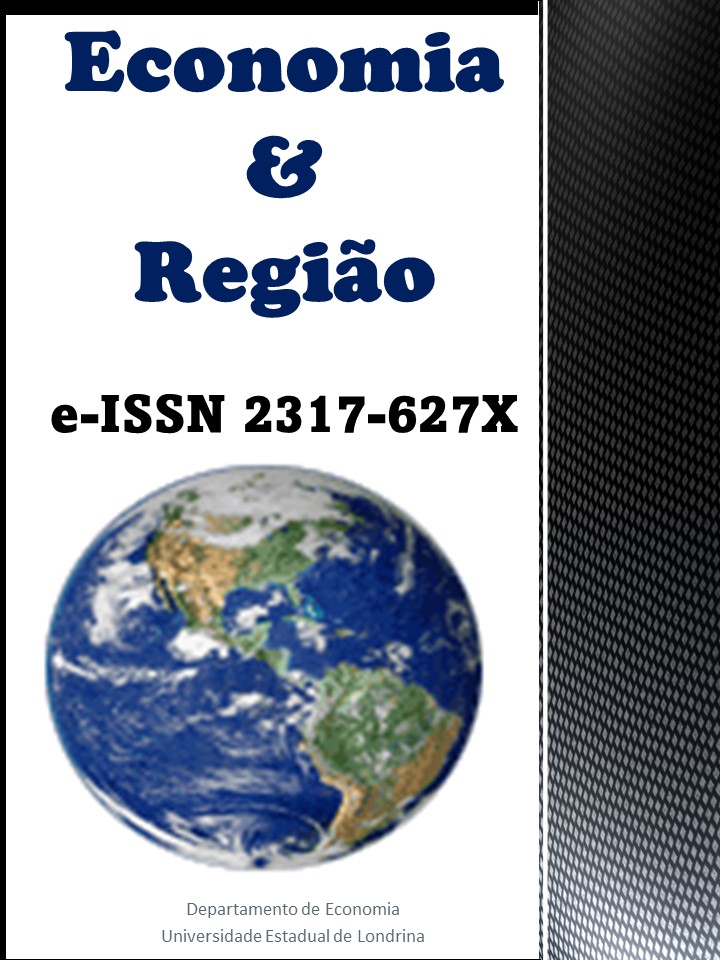The determinants of location and industrial employment of parana municipalities between 2007 and 2017
DOI:
https://doi.org/10.5433/2317-627X.2022v10n2p177Keywords:
Industry, Panel Data, Economic Development, ParanáAbstract
The aim of this study is to analyze the determinants of location in the manufacturing industry and industrial employment in the municipalities of Paraná state between 2007 and 2017. To achieve this goal, data panel methods were applied. In addition, proxies for agglomerations (urban, employment), the average size of firms, municipal expenditure on human capital and average sector income in the municipality were used in the analyses. It can be concluded that the agglomeration of employment in the municipalities affected these variables positively. In addition, the role of human capital and municipal expenditures in this function is highlighted, which, in general, have been shown to have a positive and statistical impact both on the number of firms and on employment in the industrial sector of the municipalities of Paraná.Downloads
References
ALMEIDA, E. T. DE; ROCHA, R. M. D. Labor pooling as an agglomeration factor: Evidence from the Brazilian Northeast in the 2002-2014 period. EconomiA, v. 19, n. 2, p. 236-250, 2018.
ANDRADE, A. L. M. D. A. importância da industrialização segundo Raúl Prebisch e o debate da desindustrialização no Brasil do século XXI. 2016.
AUDRETSCH, D. B.; FELDMAN, M. P. R&D spillovers and the geography of innovation and production. The American economic review, v. 86, n. 3, p. 630-640, 1996.
BAUM, C. F. Residual diagnostics for cross-section time series regression models. The Stata Journal, v. 1, n. 1, p. 101-104, 2001.
BEKELE, G. W.; JACKSON, R. Theoretical perspectives on industry clusters. Working Paper on Regional Research Institute, 2006.
BREUSCH, T. S.; PAGAN, A. R. The Lagrange multiplier test and its applications to model specification in econometrics. The review of economic studies, v. 47, n. 1, p. 239-253, 1980.
CAMAGNI, R. Economía urbana. Barcelona: Antoni Bosch, 2005.
CAMERON, A. C.; MILLER, D. L. A practitioner's guide to cluster-robust inference. Journal of Human Resources, v. 50, n. 2, p. 317-372, 2015.
CAMERON, A. C.; TRIVEDI, P. K. Microeconometrics: methods and applications. Cambridge: Cambridge university press, 2005.
CANGUSSU, R. C.; SALVATO, M. A.; NAKABASHI, L. Uma análise do capital humano sobre o nível de renda dos estados brasileiros: MRW versus Mincer. Estudos Econômicos (São Paulo), v. 40, n. 1, p. 153-183, 2010.
CANO, W. (Des) industrialização e (Sub) desenvolvimento. Cadernos do Desenvolvimento, v. 9, n. 15, p. 139-174, 2018.
COMBES, P. P. Economic structure and local growth: France, 1984-1993. Journal of urban economics, v. 47, n. 3, p. 329-355, 2000.
DRUKKER, D. M. Testing for serial correlation in linear panel-data models. The stata journal, v. 3, n. 2, p. 168-177, 2003.
FERREIRA, A. L.; DINIZ, M. B. DETERMINANTES DA CONCENTRAÇÃO GEOGRÁFICA INDUSTRIAL NO BRASIL. Revista Econômica do Nordeste, v. 50, n. 4, p. 163-182, 2019.
FOCHEZATTO, A.; TARTARUGA, I. G. P. Estrutura produtiva potencialmente inovadora e desenvolvimento local: estudo do caso dos municípios do Rio Grande do Sul usando econometria espacial. 40º ENCONTRO NACIONAL DE ECONOMIA, p. 1-18, 2012.
FOCHEZATTO, A.; VALENTINI, P. J. Economias de aglomeração e crescimento econômico regional: um estudo aplicado ao Rio Grande do Sul usando um modelo econométrico com dados de painel. Revista Economia, v. 11, n. 4, p. 243-266, 2010.
GONZÁLEZ-VAL, R.; MARCÉN, M. Agglomeration Economies in Small Cities and Business: The Impact of the Great Recession in Aragón (Spain). Sustainability, v. 11, n. 14, p. 3770, 2019.
GREENE, W. H. Econometric Analysis. 7° ed. New York: Pearson, 2012.
HAUSMAN, J. A. Specification tests in econometrics. Econometrica: Journal of the econometric society, p. 1251-1271, 1978.
HOOVER, E. M. Location Theory and the Shoe and Leather Industries. Cambridge, MA: Harvard University Press, 1937.
HOOVER, E. M. The Location of Economic Activity. New York: McGraw Hill, 1948.
ISARD, W. Location and space-economy, Technology Press of MIT Press and John Wiley and Sons inc - New York, 1956.
LAMONICA, M; T; FEIJÓ, C; A. Crescimento e industrialização no Brasil: uma interpretação à luz das propostas de Kaldor. Brazilian Journal of Political Economy, v. 31, n. 1, p. 118-138, 2011.
LUCAS, R. On the mechanics of economic development. Journal of Monetary Economics 22: 3-42, 1988.
LUNDVALL, B. National Systems of Innovation: Toward a Theory of Innovation and Interactive Learning. New York: Anthem Press, 2010.
MARSHALL, A. Principles of Economics, An Introductory Volume. London: Mcmillan, eighth edition, 1920.
NIEHUES, Leandro Garcia. A industrialização do Paraná: abordagens de um processo de desenvolvimento concentrado. Geographia Opportuno Tempore, v. 1, n. 2, p. 454-466, 2014.
NORONHA, K.; FIGUEIREDO, L. D.; ANDRADE, M. V. Health and economic growth among the states of Brazil from 1991 to 2000. Revista Brasileira de Estudos de População, v. 27, n. 2, p. 269-283, 2010.
OGUNDARI, K.; AWOKUSE, T. Human capital contribution to economic growth in Sub-Saharan Africa: does health status matter more than education? Economic Analysis and Policy, v. 58, p. 131-140, 2018.
OHLIN, B. Interregional and International Trade. Cambridge, Mass: Harvard, 1933.
PELINSKI, A. Os Determinantes da Localização Industrial por Nível Tecnológico no Paraná: Ênfase no Capital Humano. Informe GEPEC (Online), v. 15, p. 18-35, 2011.
PORTER, M. E. The competitive advantage of nations. Harvard business review, v. 68, n. 2, p. 73-93, 1990.
PRESTES, A. F.; BEZERRA, F. M.; CASTRO, T. E. DE. Análise espacial das aglomerações da indústria de transformação nos segmentos moderno e tradicional no estado do Paraná. Revista Brasileira de Estudos Regionais e Urbanos, v. 13, n. 3, p. 422-442, 5 mar. 2020.
RAIS - Relação Anual de Informações Sociais. Ministério do Trabalho e Emprego - Programa de disseminação das estatísticas do trabalho. Disponível em: <http://pdet.mte.gov.br/acesso-online-as-bases-de-dados>. Acesso em: 09/03/2020.
RESENDE, M. Industrial coagglomeration: some state-level evidence for Brazil. Nova Economia, v. 25, n. 1, p. 181-194, 2015.
ROMER, P. M. Increasing returns and long-run growth. Journal of political economy, v. 94, n. 5, p. 1002-1037, 1986.
SILVA, M.V. B. D.; SILVEIRA NETO, R. D. M. Dinâmica da concentração da atividade industrial no Brasil entre 1994 e 2004: uma análise a partir de economias de aglomeração e da nova geografia econômica. Economia Aplicada, v. 13, n. 2, p. 299-331, 2009.
SILVEIRA NETO, R. Concentração industrial regional, especialização geográfica e geografia econômica: evidências para o Brasil no período 1950-2000. Revista Econômica do Nordeste, v. 36, n. 2, p. 189-208, 2005.
SOBRINHO, G. M. E; AZZONI, R. C. Aglomerações industriais relevantes do Brasil. TD NEREUS: Núcleo de Economia Regional e Urbana da Universidade de São Paulo-USP, São Paulo, 2014.
SOUZA, L. A.; MUNIZ, A. L. P. Os fatores determinantes da localização das indústrias goianas. CEPPG Revista (Catalão), v. 23, p. 161/11-175, 2010.
WEBER, A. Theory of the Location of Industries. Trans. Friedrich, C. J. Chicago: University of Chicago Press, 1929.
WOOLDRIDGE, J. M. 2002. Econometric Analysis of Cross Section and Panel Data. Cambridge, MA: MIT Press.
WORLDBANK. Industry (including construction), value added (current US$). Disponível em: <https://data.worldbank.org/indicator/NV.IND.TOTL.CD?end=2017&most_recent_value_desc=true&start=2016>. Acesso em: 09/03/2020.
Downloads
Published
How to Cite
Issue
Section
License
Copyright (c) 2022 Economia & Região

This work is licensed under a Creative Commons Attribution 4.0 International License.
Economia & Região adota a Licença Creative Commons Attribution CC-BY 4.0 International, portanto, os direitos autorais relativos aos artigos publicados são do(s) autor(es), que cedem à Revista Economia & Região o direito de exclusividade de primeira publicação.
Sob essa licença é possível: Compartilhar - copiar e redistribuir o material em qualquer suporte ou formato. Adaptar - remixar, transformar, e criar a partir do material, atribuindo o devido crédito e prover um link para a licença e indicar se mudanças foram feitas.




















